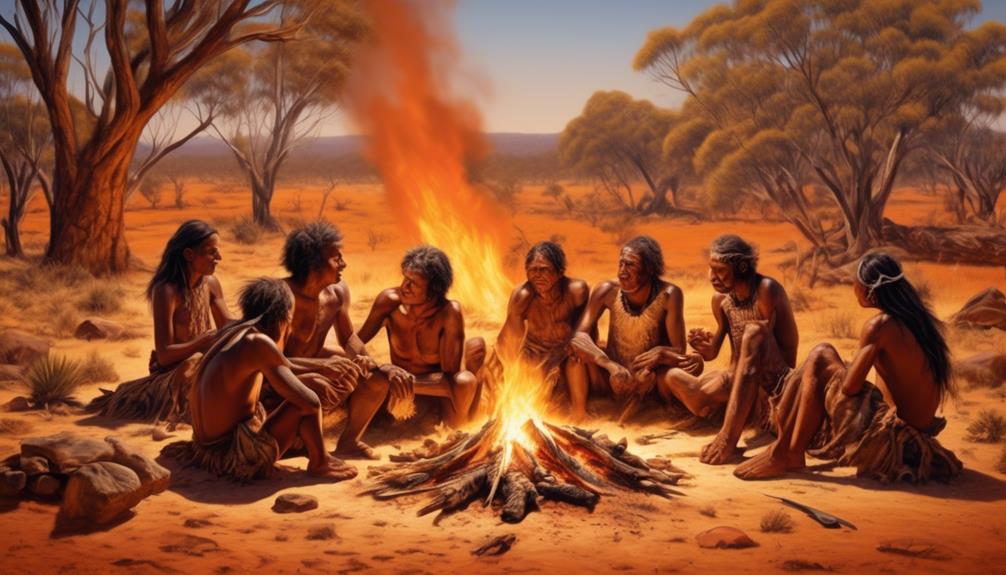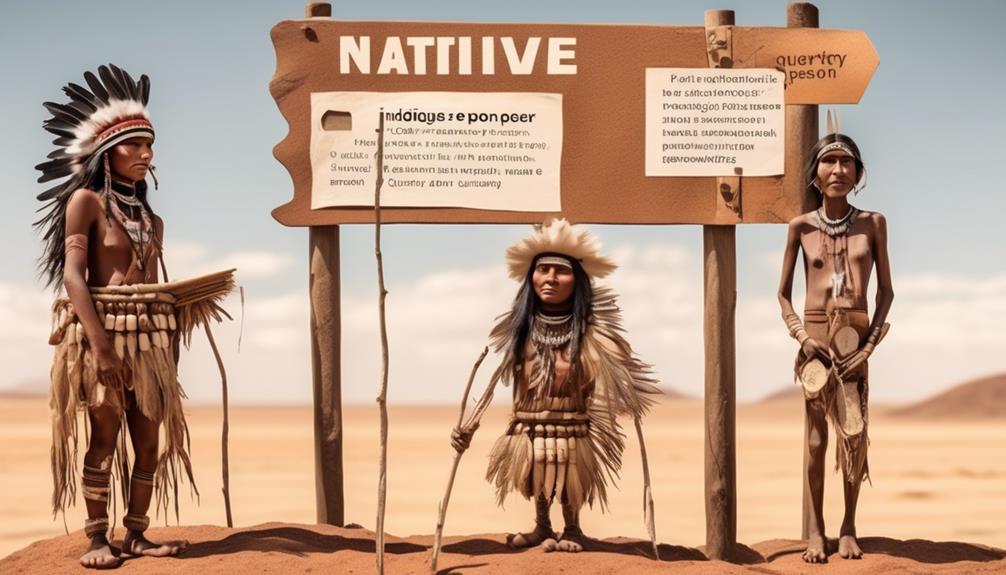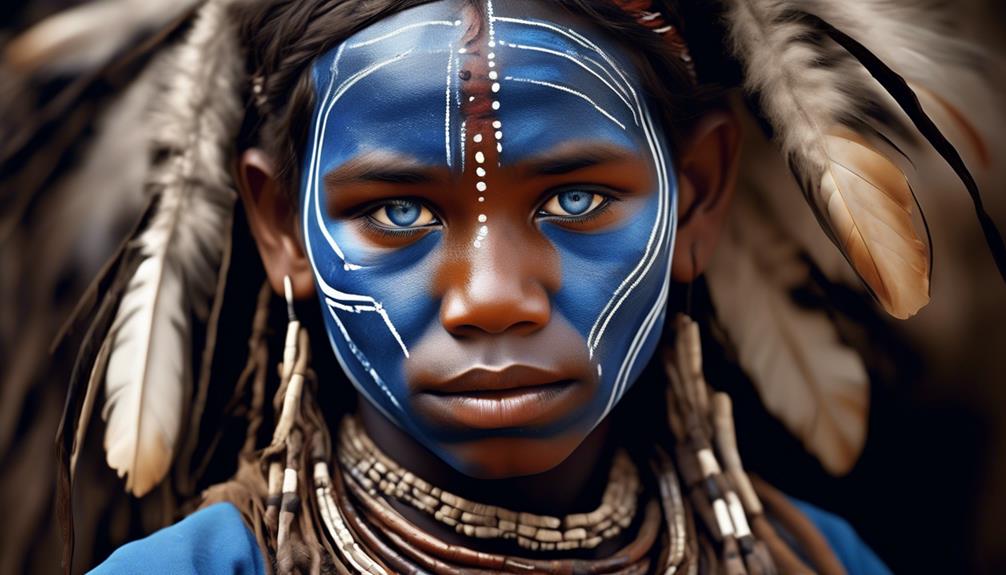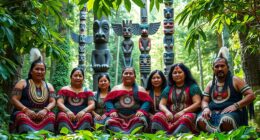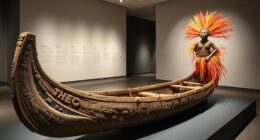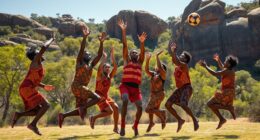Have you ever considered the different locations where Indigenous Australians reside?
There is a common misconception that all Aboriginal people live in remote and rural areas, but the reality is much more complex.
From urban centers to traditional homelands, the locations where Aboriginal Australians live are as diverse as the people themselves.
Understanding the different environments in which Aboriginal communities thrive provides valuable insight into their way of life and their connection to the land.
Key Takeaways
- Aboriginal communities in rural and remote areas face isolation and barriers to social and economic opportunities.
- Urban and suburban areas provide community support services that foster a sense of belonging, but cultural preservation is still a concern.
- Residing in traditional homelands allows for a strong cultural connection, and land rights are crucial for cultural preservation.
- Coastal and island settlements have a deep respect for the environment and a spiritual connection to the ocean, relying on fishing practices and gathering seafood for sustenance.
Rural and Remote Communities
Rural and remote communities in Australia present a unique and challenging landscape for Aboriginal Australians to navigate. The vast distances and sparse populations contribute to rural isolation, making access to essential services such as healthcare, education, and employment more difficult. In these areas, the Aboriginal communities often face significant barriers to social and economic opportunities, impacting their overall well-being.
Despite the challenges, there's a remarkable display of community resilience within these rural and remote areas. Aboriginal communities have developed strong social networks and support systems to overcome the hardships imposed by geographic isolation. These communities often rely on traditional knowledge and cultural practices to sustain themselves, fostering a deep connection to the land and a profound sense of belonging.
Comparatively, the resilience and resourcefulness demonstrated by Aboriginal Australians in rural and remote communities serve as a testament to the strength and adaptability of these individuals. Their ability to thrive in such challenging environments is a reflection of their deep-rooted connection to the land and their unwavering commitment to preserving their culture and heritage.
Urban and Suburban Areas

Navigating from the challenges of rural and remote communities, Aboriginal Australians in urban and suburban areas encounter a different set of opportunities and obstacles. Urban migration has brought us closer to educational and employment prospects, better healthcare, and improved infrastructure. However, it has also presented challenges such as social disconnection and the preservation of cultural identity.
- Community Support: In urban and suburban areas, Aboriginal Australians often find more extensive community support services, including cultural centers, legal aid, and social programs. These resources help us maintain a sense of belonging and connection to our heritage while navigating the complexities of urban life.
- Cultural Preservation: Despite the allure of urban living, the preservation of our cultural practices and traditions remains a constant concern. Many of us actively seek ways to uphold our customs through community events, art initiatives, and cultural education programs, ensuring the continuity of our rich heritage.
- Identity and Representation: In urban and suburban areas, there's an increasing need for positive representation and acknowledgment of Aboriginal Australians. Efforts to celebrate our contributions to society and combat negative stereotypes are vital for fostering understanding and inclusion within the broader community.
Traditional Homelands
Residing in our traditional homelands provides us with a profound connection to our ancestral roots and a deep sense of cultural belonging. The land rights associated with our traditional homelands are crucial for maintaining our cultural preservation. These areas aren't just physical spaces; they're repositories of our stories, wisdom, and traditions. We've an intimate understanding of the land, its plants, animals, and natural resources, which have sustained us for generations. Our traditional homelands offer a unique way of life, distinct from urban and suburban areas. The interconnectedness with nature and the ability to practice our customs freely are fundamental to our well-being and cultural identity.
The struggle for land rights has been a significant part of our history, as it directly impacts our ability to maintain our traditional homelands. These rights are essential for the preservation of our cultural heritage and the continuation of our traditional practices. The significance of these homelands can't be overstated; they're the heart of our existence, providing us with a sense of belonging and purpose. The ongoing recognition and support for our land rights are vital for the continuation of our cultural legacy.
Coastal and Island Settlements

Nestled along the pristine coastlines and scattered throughout the remote islands, our coastal and island settlements embody a unique way of life deeply intertwined with the ebb and flow of the ocean.
The coastal communities exhibit a remarkable reliance on fishing practices, where we observe the art of net fishing, spearing, and gathering seafood from the tidal zones.
Cultural preservation is paramount in these settlements, where traditions of storytelling, song, and dance are passed down through generations, strengthening our bond with the land and sea.
The interconnectedness with the ocean not only shapes our daily sustenance but also provides a spiritual connection, emphasizing the importance of cherishing and protecting our marine ecosystems.
The rhythm of life in these settlements mirrors the tides, with our days dictated by the movements of the sea and the cycles of nature. We find solace and sustenance in the bounty of the ocean, and our practices reflect a deep respect for the environment and a profound understanding of our place within it.
Reservations and Indigenous Protected Areas
Indigenous communities across Australia actively manage and safeguard their lands through a network of reservations and Indigenous Protected Areas, demonstrating a profound commitment to preserving their cultural and environmental heritage. These areas are essential for preserving traditional land rights and cultural preservation, ensuring that the connection between Aboriginal Australians and their ancestral lands remains intact. The reservations and Indigenous Protected Areas serve as living landscapes, where cultural practices and wisdom are passed down through generations, fostering a deep sense of identity and belonging.
Moreover, these areas play a crucial role in conservation and environmental stewardship. They act as sanctuaries for a diverse range of flora and fauna, some of which are endemic to these regions. By actively participating in land management and conservation efforts, Indigenous communities showcase their deep understanding of sustainable practices that have been honed over thousands of years. This knowledge is invaluable in today's world, where environmental sustainability is a growing concern.
The Indigenous Protected Areas not only benefit the Indigenous communities but also contribute significantly to the broader conservation efforts in Australia.
Frequently Asked Questions
What Are the Main Challenges Faced by Aboriginal Australians Living in Rural and Remote Communities?
Living in remote communities presents unique challenges. Health disparities and limited access to resources are significant issues. These challenges can impact the overall well-being of the community.
It's essential to address these disparities and ensure equitable access to healthcare and resources. By understanding these challenges, we can work towards creating solutions that will improve the quality of life for those living in remote areas.
How Has Urbanization Impacted the Traditional Lifestyles of Aboriginal Australians Living in Urban and Suburban Areas?
Urbanization has transformed the traditional lifestyles of many communities worldwide. Observing the impact of urbanization on cultural preservation in urban areas is crucial.
It's essential to understand how communities adapt and maintain their cultural practices amidst urbanization. The changes in lifestyle, social structures, and access to resources are significant factors. Understanding these dynamics is vital for supporting communities in preserving their traditions while navigating urban environments.
What Are the Cultural Significance and Importance of Traditional Homelands for Aboriginal Australians?
Traditional homelands hold immense cultural significance for Aboriginal Australians. They're vital for cultural preservation, land ownership, and the transmission of traditional knowledge. These spaces foster a deep sense of community connection, providing a foundation for the continuation of cultural practices and identity.
For instance, the interconnectedness between the land and the people in traditional homelands evokes a profound emotional attachment, emphasizing the importance of these spaces in sustaining Aboriginal culture.
How Have Aboriginal Australians Adapted to Living in Coastal and Island Settlements, and What Are Some of the Unique Aspects of Their Way of Life in These Areas?
Living in coastal and island settlements requires a specific set of skills and adaptations. We've observed that Aboriginal Australians have developed unique ways of life in these areas, such as specialized fishing techniques and a deep understanding of the marine environment.
Their cultural practices, including storytelling and art, also reflect the significance of coastal and island living. These adaptations demonstrate their resilience and ingenuity in creating sustainable communities in diverse environments.
What Are the Differences Between Reservations and Indigenous Protected Areas, and How Do They Impact the Lives of Aboriginal Australians Living in These Areas?
Reservations and Indigenous Protected Areas serve distinct purposes for land ownership and conservation efforts. Reservations often have more government control, while Indigenous Protected Areas prioritize indigenous management. These differing approaches impact the lives of Aboriginal Australians.
Reservations may restrict traditional practices, while Indigenous Protected Areas allow for more cultural autonomy. Both play a role in shaping the way Aboriginal Australians interact with their land and environment.
Conclusion
As we journeyed through the diverse landscapes of Australia, we witnessed the resilient spirit of Aboriginal communities, each place telling its own story of survival and strength.
From the sprawling outback to the bustling city streets, their presence is felt, like ancient roots grounding them to the land.
It's a reminder that they're the guardians of this country, connected to the earth in a way that's both beautiful and humbling.
Mary is a passionate writer who brings creativity and a fresh perspective to our team. Her words have the power to captivate and inspire, making her an essential contributor to our content. Mary’s commitment to storytelling and dedication to promoting Indigenous culture ensures that her work touches the hearts of our readers. We’re fortunate to have her as part of our team.

